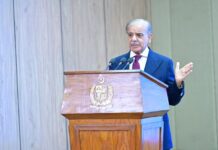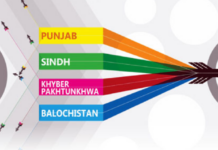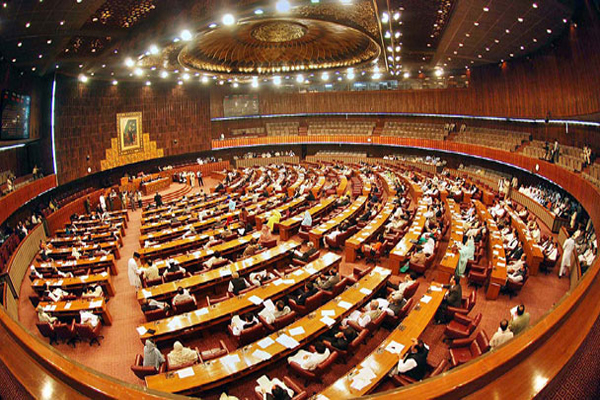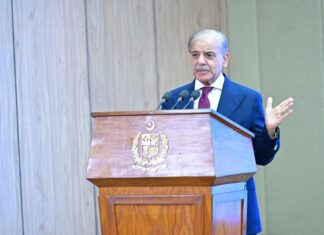The National Assembly on Tuesday approved a comprehensive set of budgetary grants across major sectors of the federal government, backing allocations for the Cabinet and Commerce Divisions, as well as 69 other federal departments and institutions. The approvals came through voice votes and followed the dismissal of hundreds of cut motions submitted by opposition members.
Finance Minister Muhammad Aurangzeb presented 69 demands for grants amounting to Rs 1.65 trillion, which were passed without amendment. These cover an expansive list of departments including the Climate Change and Environmental Coordination Division, Communications Division, Pakistan Post Office Department, Defense Production Division, Economic Affairs Division, Federal Education and Professional Training Division, and the Higher Education Commission (HEC). Also included are the National Rahmatul-Lil-Aalameen Wa Khatamun Nabiyyin Authority, the National Vocational and Technical Training Commission (NAVTTC), the National Heritage and Culture Division, Foreign Affairs Division and Foreign Missions, Housing and Works Division, Industries and Production Division, and the Information and Broadcasting Division.
Further funding was approved for the Information Technology and Telecommunication Division, Inter-Provincial Coordination Division, Kashmir Affairs, Gilgit-Baltistan and States and Frontier Regions Division, Law and Justice Division, the Federal Judicial Academy, the Federal Shariat Court, the Council of Islamic Ideology, the National Accountability Bureau, the District Judiciary, Islamabad Capital Territory, the Maritime Affairs Division, the National Assembly, the Senate, and the National Health Services, Regulations and Coordination Division. Additional approvals were granted to the Overseas Pakistanis and Human Resource Development Division, Parliamentary Affairs Division, Planning, Development and Special Initiatives Division, Poverty Alleviation and Social Safety Division, Benazir Income Support Programme (BISP), Pakistan Bait-ul-Mal, the Privatization Division, the Railways Division, the Religious Affairs and Inter-Faith Harmony Division, the Science and Technology Division, and the Water Resources Division.
Development expenditures were sanctioned for a number of these divisions, including Climate Change, Communications, Defense Production, Federal Education, HEC, NAVTTC, Heritage and Culture, Information and Broadcasting, IT and Telecom, Inter-Provincial Coordination, Kashmir Affairs, Law and Justice, and Health Services. Additional allocations cover the Parliamentary Affairs Division, Planning and Development, Religious Affairs, Science and Technology, and Water Resources. External development loans and advances were approved for the Communications and Water Resources divisions, as well as capital outlays on civil works, industrial development, maritime affairs, railways, the national security division, the Intelligence Bureau, and the development of atomic energy.
The House also passed Rs 81.45 billion in grants for the Cabinet Division, including funding for the emergency relief and repatriation programs, atomic energy, the Pakistan Nuclear Regulatory Authority, the Naya Pakistan Housing Development Authority, and both the Internal and Public wings of the Prime Minister’s Office. Additional allocations covered the National Disaster Management Authority, the Board of Investment, the Prime Minister’s Inspection Commission, the Special Technology Zones Authority, the National Anti-Money Laundering and Counter Financing Terrorism Authority, the Cannabis Control and Regulatory Authority, the Establishment Division, the Federal Public Service Commission, the National School of Public Policy, the Civil Services Academy, the National Security Division, the Council of Common Interest Secretariat, the Special Investment Facilitation Council Division (SIFCD), the Intelligence Bureau Division, and capital outlay on the development of atomic energy.
Parliamentary Affairs Minister Dr. Fazal Chaudhary, in his response to the opposition, defended the cabinet size and the government’s economic record. He said the current federal cabinet has 42 members, staying within the constitutional limit of 11% of National Assembly membership as set by Article 92(1), which allows up to 46 members. He stated that when the government came into office, the economy was on the verge of collapse, but now key indicators have stabilized. He attributed this turnaround to the revival of the China-Pakistan Economic Corridor (CPEC), structural reforms in taxation and investment, and renewed momentum in the energy and agriculture sectors. Dr. Fazal also pointed to progress in minerals and mining, calling Pakistan’s resources a trillion-dollar opportunity now being explored with international partners. He praised Prime Minister Shehbaz Sharif and Field Marshal Syed Asim Munir, commending the armed forces’ regional and global strength. The Special Investment Facilitation Council (SIFC), he added, has successfully attracted billions in foreign investment by removing bureaucratic hurdles and fast-tracking implementation.
He said the NDMA is now fully functional across all provinces and has received international praise for its improved coordination. On sustainable development goals, he noted the government’s active focus on infrastructure, healthcare, education, and climate initiatives. Addressing the stalled Naya Pakistan Housing Program, he revealed that five projects left incomplete by the previous administration are now being revived. He added that the Cabinet Division is also responsible for administering civil awards and is working to promote tourism despite it being a provincial subject.
Meanwhile, the House also passed two demands for grants worth over Rs 26.99 billion for the Commerce Division. These included Rs 26,948,574,000 for operational expenditure and Rs 50,000,000 for development. Commerce Minister Jam Kamal Khan emphasized that the government’s $60 billion export target is backed by extensive planning under the Strategic Trade Policy Framework (STPF) 2024–30, developed through consultations with 17 sectoral councils and both federal and provincial stakeholders. He said the strategy addresses production costs, taxation, legal barriers, and institutional reform, and is rooted in a deep analysis of global trade dynamics. He dismissed suggestions that the plan was made in isolation, asserting that private sector engagement played a central role.
The minister highlighted key recent achievements, including a five-year high in Basmati rice exports of $3.3 billion, despite India returning to the market with reduced prices. He corrected reports of lower national export figures, affirming that total exports stand closer to $30 billion. He also revealed that Pakistan achieved $8 billion in agro-food exports in the past year, its highest ever.
He said that commercial attachés have been renamed Trade and Investment Officers (TIOs), who are now selected through a competitive, merit-based process involving private sector input. These officers are tasked with reporting daily via a new Electronic Trade Analysis Portal, and are evaluated through defined KPIs and TORs. The government has also created Pakistan’s first National Compliance Council to support exporters, especially SMEs, in meeting global standards, and has appointed the Commerce Ministry’s first Head of Research.
Jam Kamal said the ministry is also finalizing Pakistan’s first-ever Domestic Commerce Policy to enhance local production and surplus, with agro-food and food technology identified as key export sectors. He noted that institutions like the Export Development Fund (EDF) and the Trade Development Authority of Pakistan (TDAP) have been restructured and revitalized. The federal budget, he added, supports domestic manufacturers by reducing duties on local raw material inputs under a five-year industrial plan. Reforms are being monitored by a steering committee led by the Finance Minister, with regular reviews held every 10 to 15 days. He concluded by noting that trade and industrial reforms are already showing results and will continue to improve outcomes in the months ahead.























